Hardwick Hall Hotel, Sedgefield
Hardwick Hall in Sedgefield, County Durham is a building of historical significance and is listed on the English Heritage Register. A major part of it was built in the late 1700s but it is possible that some of it dates from about 1634. It was the residence for many notable people for two centuries. It is now a hotel which provides accommodation and restaurant services and caters for special events particularly weddings.
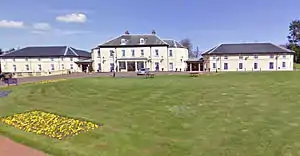
Early History
«About half a mile west of Sedgefield stands the manor and hall of Hardwick. Under Hatfield's Survey, Roger Fulthorp and John Herdwick held this manor, by homage, fealty, suit of court, and 10s rent. In 1391, Thomas Watkinson, of Elstop, was seized of a moiety of the manor. John de Herdwick died, seized of his proportion, in the 9th year of Bishop Skirlaw; and Agnes, his daughter and heiress, married Gilbert de Hoton, who died in the 12th year of the same prelate, seized in her right, leaving John his son and heir. The families of Cramlington and Killinghall soon after held possessions here; and, in 1500, John Hebborne, in right of Ellen his wife, and William Hansard, in right of Elizabeth his wife, as daughters and coheiresses of John Hoton, had livery of his lands. Soon afterwards, Hardwick appears to have been wholly the estate of the Hebbornes: and John Hebborne, Esq., in 1507, obtained licence to alien the manors or townships of Herdwick and Shotton, nigh Sedgefield, to Anthony Mitford and others; which alienation must have been in trust or settlement, for Anthony Hebborne, Esq.; whilst he was seized of the manor, was attainted of high treason in the Northern Rebellion, and forfeited his manor of Hardwick and lands in Mainsforth and Bishop-Middleham. In the 32d year of Queen Elizabeth, Hardwick was granted, by letters patent, to George Frevill, Esq., as a reward for his services during the rebellion, with remainder to Elizabeth his wife, and to William Jennison, under a reserved rent of £25, 19s. 6d.»[1]
The Frevilles and Lambtons
In 1590 the manor of Hardwick was granted to George Freville. He was knighted by King James at York, 17th April, 1603.[2] George Freville died childless in 1619, leaving his lands to his younger nephew Nicholas. In 1645 Nicholas compounded for his Hardwick estate. He died in 1674, leaving three daughters and co-heirs, Elizabeth, Mary, and Margaret widow of Thomas Lambton. Freville Lambton, son of Margaret, had Hardwick by the will of his grandfather. He and his mother, then the widow of Nicholas Conyers of Biddick Waterville,[3][4] made a settlement of the manor in 1687. Freville Lambton married 1) Ann Milward, of Uttoxeter, Stafford; 2) Thomasine Milward; and 3) Anne, daughter of Sir Robert Wright, English judge and Chief Justice of the King’s Bench and sister of Robert Wright for who the Manor House in Sedgefield was built in 1707.[5] By his second wife, he had his son and heir, Thomas, who had six daughters and co-heirs: Barbara, Dorothy, Thomasina, Philadelphia, Margaret and Elizabeth. They sold Hardwick in 1748 to John Burdon, who in 1780 conveyed it to William Russell, retaining a life interest.[6][7][1]
John Burdon
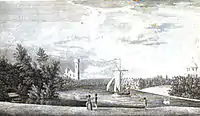

John Burdon (1711-1792) is credited with being the main originator of Hardwick Hall. However Pevsner believes that he built on an existing manor which was constructed in 1634.[8] The advertisement for the Hardwick Estate sold by the Lambton family in 1747 just before Burdon bought it states that there exists a “good Mansion House”[9] so it is possible that he made major alterations and additions to this building.
John Burdon was born in 1711 in South Shields, Durham. His father was Nicholas Burdon an immensely wealthy salt and shipping merchant. He remained a bachelor all of his life. When his father died in 1847 John inherited his fortune[10] and so was able to purchase the Hardwick Estate and spend a very large sum on creating the elaborate pleasure gardens. The gardens were described in numerous publications of the time. Hutchinson in 1785 says that they are “laid out with exquisite taste” and then outlines in detail the buildings and ornaments that can be seen in a walk around the park.[11] The book includes an engraved drawing of the park which is shown.
In 1790 at the age of 79 John sold the Hardwick Estate to William Russell.
The Russell Family
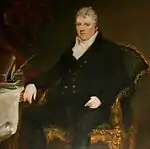
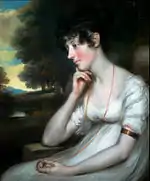
William Russell (1734-1817) was a very wealthy banker and merchant. In 1796 he bought Brancepeth Castle and it seems that from about his time his son Matthew took over the running of Hardwick Hall and made many improvements to the house and garden.
Matthew Russell (1765-1822) was born in 1765. He was educated at Oxford University and later became a Member of Parliament.[12] In 1798 he married Elizabeth Tennyson, the daughter of George Tennyson of Bayons Manor Lincolnshire. Elizabeth was the favourite aunt of Alfred, Lord Tennyson and he frequently sent letters to her.[13] As he was often in financial difficulties she sent him generous gifts of money which he greatly appreciated.
The couple had two children William Russell (1798–1850) and Emma Maria Russell (1809-1870).
In 1817 Matthew's father died and he inherited his vast fortune and Brancepeth Castle. From this time he spent most of his energies on his new home and Hardwick Hall gardens began to decline. He died in 1822 and his son William Russell (1798-1850) inherited the property. William did not live in the house and instead rented it to various noblemen and merchants. When he died in 1850 his sister Emma Maria inherited Brancepeth Castle and Hardwick Hall.[14] She had married Gustavus Frederick Hamilton in 1828 and he had agreed to change his name to Hamilton-Russell when she gained the family fortune in 1850. Hardwick Hall was now the property of the Hamilton-Russell family
The Hamilton-Russell Family
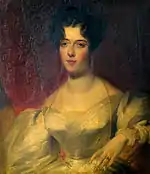
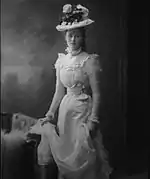
Gustavus Frederick Hamilton-Russell was the 7th Viscount Boyne. His father was Gustavus Hamilton 6th Viscount Boyne who owned Burwarton House in Shropshire. He married Emma Maria Russell, the daughter of Matthew Russell (outlined above) in 1828. They lived in London for many years and when Emma inherited Hardwick Hall in 1850 they did not move to the house but instead continued to lease it to tenants.[15]
The 7th Viscount Boyne died in 1872 and his son Gustavus Russell Hamilton-Russell (1830-1907) (8th Viscount Boyne) inherited the Hall but he also continued to rent it out. However, in about 1890 his son Gustavus William Hamilton Russell (who later became 9th Viscount Boyne) decided to live there.[16]
Gustavus William Hamilton Russell 9th Viscount Boyne (1864-1942) was born in 1864 in Ireland. He was educated at Eton and then went to Cambridge University. He managed the Hardwick Hall Estate from about 1885. In 1906 he married Margaret Selena Lascelles. Margaret Lascelles was the sister-in law of Princess Mary, daughter of King George V. Her brother Henry Lascelles was the 6th Earl of Harewood and had married Princess Mary in 1922.[17]
Gustavus and Margaret had six children – five sons and one daughter. Unfortunately three of their sons died in World War ll. One of these, John Hamilton-Russell was married shortly before he went to war and a film of his wedding which was attended by his aunt Princess Mary is available on the British Pathe website.[18]
Use as a Maternity Home
After the Second World War, Hardwick Hall was used as a Maternity Home until the early 1960s Hardwick Hall was used during the Second World War as an evacuation maternity home during the bombing of Sunderland.
References
- Mackenzie, Eneas; Ross, Marvin (1834). An Historical, Topographical, and Descriptive View of the County Palatine of Durham: Comprehending the Various Subjects of Natural, Civil, and Ecclesiastical Geography, Agriculture, Mines, Manufactures, Navigation, Trade, Commerce, Buildings, Antiquities, Curiosities, Public Institutions, Charities, Population, Customs, Biography, Local History, &c. Mackenzie and Dent.
- Sharp, Sir Cuthbert (1840). Memorials of the Rebellion of 1569. [Being selections from the Bowes MSS. With an appendix. Edited, with notes, by Sir C. Sharpe.].
- "CONYERS, Thomas (?1666-1728), of Elemore, nr. Durham. | History of Parliament Online". www.historyofparliamentonline.org. Retrieved 28 July 2020.
- "CONYERS, Thomas (c.1666-1728), of Eelemore, nr. Durham | History of Parliament Online". www.historyofparliamentonline.org. Retrieved 28 July 2020.
- Parsons, Ean (2018). Hidden in Full View. The History of the Chief Justice of Carolina's Mansion House in Sedgefield. ISBN 978-1-5272-2612-8.
- "Parishes: Sedgefield | British History Online". www.british-history.ac.uk. Retrieved 28 July 2020.
- f.a.s, will hutchinson (1823). HISTORY & ANTIQUITTES OF THE COUNTY PALATINE OF BURLIAM.
- Pevsner, Nikolaus; Williamson, Elizabeth (12 March 2015). County Durham. Google Books. ISBN 978-0300095999. Retrieved 22 March 2015. p. 301.
- Newcastle Courant - Saturday 30 May 1747, p. 3.
- Faulkner, Tom E.; Berry, Helen; Gregory, Jeremy (12 March 2015). Northern Landscapes. Google Books. ISBN 9781843835417. Retrieved 22 March 2015. p. 70.
- Hutchinson, William 1785 “The history and antiquities of the county palatine of Durham”, Vol 3, p. 65. Online reference http://babel.hathitrust.org/cgi/pt?id=hvd.hnfd6c;view=1up;seq=99
- The History of Parliament website. Online reference http://www.historyofparliamentonline.org/volume/1790-1820/member/russell-matthew-1765-1822
- Lang, Cecil Y.; Shannon, Edgar Finley (12 March 2015). The Letters of Alfred Lord Tennyson, 1851-1870. Google Books. ISBN 9780674525849. Retrieved 22 March 2015.
- The History of Parliament. Online reference http://www.historyofparliamentonline.org/volume/1820-1832/member/russell-william-1798-1850
- See England Census for 1851, 1861, 1871 and 1881.
- See England Census for 1891, 1901 and 1911.
- The Peerage. Online reference http://www.thepeerage.com/p10072.htm#i100715
- British Pathe website. Online reference http://www.britishpathe.com/video/princess-royal-attends-wedding-in-brompton
